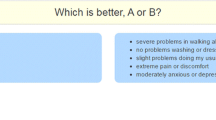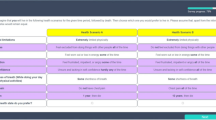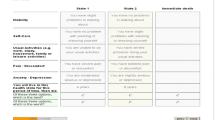Abstract
Purpose
To assess the feasibility of using a discrete choice experiment (DCE) to value health states within the QLU-C10D, a utility instrument derived from the QLQ-C30, and to assess clarity, difficulty, and respondent preference between two presentation formats.
Methods
We ran a DCE valuation task in an online panel (N = 430). Respondents answered 16 choice pairs; in half of these, differences between dimensions were highlighted, and in the remainder, common dimensions were described in text and differing attributes were tabulated. To simplify the cognitive task, only four of the QLU-C10D’s ten dimensions differed per choice set. We assessed difficulty and clarity of the valuation task with Likert-type scales, and respondents were asked which format they preferred. We analysed the DCE data by format with a conditional logit model and used Chi-squared tests to compare other responses by format. Semi-structured telephone interviews (N = 8) explored respondents’ cognitive approaches to the valuation task.
Results
Four hundred and forty-nine individuals were recruited, 430 completed at least one choice set, and 422/449 (94 %) completed all 16 choice sets. Interviews revealed that respondents found ten domains difficult but manageable, many adopting simplifying heuristics. Results for clarity and difficulty were identical between formats, but the “highlight” format was preferred by 68 % of respondents. Conditional logit parameter estimates were monotonic within domains, suggesting respondents were able to complete the DCE sensibly, yielding valid results.
Conclusion
A DCE valuation task in which only four of the QLU-C10D’s ten dimensions differed in any choice set is feasible for deriving utility weights for the QLU-C10D.



Similar content being viewed by others
References
Bansback, N., Brazier, J., Tsuchiya, A., & Anis, A. (2012). Using a discrete choice experiment to estimate societal health state utility values. Journal of Health Economics, 31, 306–318.
Norman, R., Cronin, P., & Viney, R. (2013). A pilot discrete choice experiment to explore preferences for EQ-5D-5L health states. Applied Health Economics and Health Policy, 11(3), 287–298.
Norman, R., Viney, R., Brazier, J., Burgess, L., Cronin, P., King, M., et al. (2014). Valuing SF-6D health states using a discrete choice experiment. Medical Decision Making, 34(6), 773–786.
Stolk, E. A., Oppe, M., Scalone, L., & Krabbe, P. F. M. (2010). Discrete choice modeling for the quantification of health states: The case of the EQ-5D. Value in Health, 13(8), 1005–1013.
Viney, R., Norman, R., Brazier, J., Cronin, P., King, M. T., Ratcliffe, J., & Street, D. (2014). An Australian discrete choice experiment to value EQ-5D health states. Health Economics, 23(6), 729–742.
Louviere, J., Carson, R. T., Burgess, L., Street, D., & Marley, A. A. (2013). Sequential preference question factors influencing completion rates and response times using an online panel. The Journal of Choice Modelling, 8, 19–31.
Brazier, J., Roberts, J., & Deverill, M. (2002). The estimation of a preference-based measure of health from the SF-36. Journal of Health Economics, 21(2), 271–292.
Brazier, J., & Roberts, J. (2004). The estimation of a preference-based measure of health from the SF-12. Medical Care, 42(9), 851–859.
Rowen, D., Brazier, J., Young, T., Gaugris, S., Craig, B. M., King, M. T., & Velikova, G. (2011). Deriving a preference-based measure for cancer using the EORTC QLQ-C30. Value in Health, 14(5), 721–731.
King, M. T., Costa, D. S. J., Aaronson, N. K., Brazier, J. E., Cella, D. F., Fayers, P. M., et al. (submitted). QLU-C10D: A health state classification system for a multi-attribute utility measure based on the EORTC QLQ-C30. Quality of Life Research (currently under review).
Ware, J. E., Jr., & Gandek, B. (1998). Overview of the SF-36 health survey and the international quality of life assessment (IQOLA) project. Journal of Clinical Epidemiology, 51(11), 903–912.
Aaronson, N. K., Ahmedzai, S., Bergman, B., Bullinger, M., Cull, A., Duez, N. J., et al. (1993). The European Organisation for Research and Treatment of Cancer QLQ-C30: A quality-of-life instrument for use in international clinical trials in oncology. Journal of the National Cancer Institute, 85(5), 365–376.
Kessler, R. C., Andrews, G., Colpe, L. J., Hiripi, E., Mroczek, D. K., Normand, S. L., et al. (2002). Short screening scales to monitor population prevalences and trends in non-specific psychological distress. Psychological Medicine, 32(6), 959–976.
Herdman, M., Gudex, C., Lloyd, A., Janssen, M. F., Kind, P., Parkin, D., et al. (2011). Development and preliminary testing of the new five-level version of EQ-5D (EQ-5D-5L). Quality of Life Research, 20(10), 1727–1736.
Colbourn, C. J., & Dinitz, J. H. (2006). Handbook of Combinatorial designs. Boca Raton, FL: Taylor and Francis.
Street, D. J., & Burgess, L. (2007). The construction of optimal stated choice experiments: Theory and methods. Hoboken, NJ: Wiley.
Demirkale, F., Donovan, D., & Street, D. J. (2013). Constructing D-optimal symmetric stated preference discrete choice experiments. Journal of Statistical Planning and Inference, 143, 1380–1391.
Bleichrodt, H., & Johannesson, M. (1997). The validity of QALYs: An experimental test of constant proportional tradeoff and utility independence. Medical Decision Making, 17(1), 21–32.
Bleichrodt, N., Wakker, P., & Johannesson, M. (1997). Characterizing QALYs by risk neutrality. Journal of Risk and Uncertainty, 15(2), 107–114.
Ritchie, J., & Spencer, L. (1994). Qualitative data analysis for applied policy research. In A. Bryman & R. Burgess (Eds.), Analyzing qualitative data (pp. 173–194). London: Routledge.
Craig, B. M., Reeve, B. B., Brown, P. M., Cella, D., Hays, R. D., Lipscomb, J., et al. (2014). US valuation of health outcomes measured using the PROMIS-29. Value in Health, 17(8), 846–853.
Chrzan, K. (2010). Using partial profile choice experiments to handle large numbers of attributes. International Journal of Marketing Research, 52(6), 827–840.
Flynn, T. (2010). Using conjoint analysis to estimate health state values for cost-utility analysis: Issues to consider. Pharmacoeconomics, 28(9), 711–722.
Vass, C., Rigby, D., Campbell, S., Tate, K., Stewart, A., & Payne, K. (2014). PS2-33 investigating the framing of risk attributes in a discrete choice experiment: An application of eye-tracking and think aloud. In Paper presented at the 36th meeting of the Society for Medical Decision Making, Miami, FL.
Krucien, N., Ryan, M., & Hermens, F. (2014). Using eye-tracking methods to inform decision making processes in discrete choice experiments, Health Economists’ Study Group (HESG). Glasgow Caledonian University.
Whitty, J. A., Ratcliffe, J., Chen, G., & Scuffham, P. A. (2014). Australian public preferences for the funding of new health technologies: A comparison of discrete choice and profile case best–worst scaling methods. Medical Decision Making, 34(5), 638–654.
van der Pol, M., Currie, G., Kromm, S., & Ryan, M. (2014). Specification of the utility function in discrete choice experiments. Value in Health, 17(2), 297–301.
Mulhern, B., Bansback, N., Brazier, J., Buckingham, K., Cairns, J., Devlin, N., et al. (2014). Preparatory study for the revaluation of the EQ-5D tariff: Methodology report. Health Technology Assessment, 18(12), vii–xxvi, 1–191.
Bansback, N., Tsuchiya, A., Brazier, J., & Anis, A. (2012). Canadian valuation of EQ-5D health states: Preliminary value set and considerations for future valuation studies. PLoS One, 7(2), e31115.
Acknowledgments
The MAUCa Consortium, in addition to those named as authors, consists of the following members, all of whom made some contribution to the research reported in this paper: Helen McTaggart-Cowan, Peter Grimison, Monika Janda, and Julie Pallant. This research was supported by a National Health and Medical Research Council (Australia) Project Grant (632662). Associate Professor Janda was supported by a NHMRC Career Development Award 1045247. Dr. Norman was supported by a NHMRC early career research fellowship (1069732). Professor King was supported by the Australian Government through Cancer Australia.
Funding
This research was supported by a National Health and Medical Research Council (Australia) Project Grant (632662). Dr. Norman was supported by a NHMRC early career research fellowship (1069732). Professor King was supported by the Australian Government through Cancer Australia.
Author information
Authors and Affiliations
Corresponding author
Ethics declarations
Conflict of interest
The authors declare they do not have conflicts of interest.
Ethical approval
All procedures performed in studies involving human participants were in accordance with the ethical standards of the institutional and/or national research committee and with the 1964 Helsinki Declaration and its later amendments or comparable ethical standards. The study was approved by the University of Sydney Human Research Ethics Committee, Approval Number 2012/2444.
Informed consent
Informed consent was obtained from all individual participants included in the study.
Additional information
On behalf of the MAUCa Consortium.
An erratum to this article is available at http://dx.doi.org/10.1007/s11136-017-1546-0.
An erratum to this article is available at http://dx.doi.org/10.1007/s11136-016-1289-3.
Electronic supplementary material
Below is the link to the electronic supplementary material.
Rights and permissions
About this article
Cite this article
Norman, R., Viney, R., Aaronson, N.K. et al. Using a discrete choice experiment to value the QLU-C10D: feasibility and sensitivity to presentation format. Qual Life Res 25, 637–649 (2016). https://doi.org/10.1007/s11136-015-1115-3
Accepted:
Published:
Issue Date:
DOI: https://doi.org/10.1007/s11136-015-1115-3




